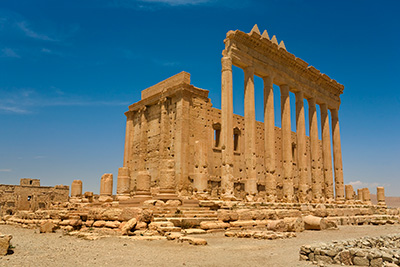Digital Reconstruction of Ancient Temple on Display in UC San Diego Library’s Art of Science Exhibit
Open Heritage 3D project also hosts imagery from the temple and other historic sites
Story by:
Published Date
Article Content
A photorealistic digital model of the ancient Temple of Bel in Palmyra, Syria, is currently on display at the UC San Diego Library and the San Diego Natural History Museum (The Nat) in Balboa Park as part of an Art of Science exhibit featuring nine winning images from the Library’s 2023 Art of Science contest.
“Our model includes every individual stone and can help enable the temple’s reconstruction from its rubble,” said Scott Mcavoy, a data systems analyst with the UC San Diego Qualcomm Institute (QI). “Uniquely, we focus on the high-resolution artworks and inscriptions, which once covered the highly ornate temple. It is a key reference for architects, historians, iconographers and epigraphers interested in the site.”
Dedicated in 32 AD, the Temple of Bel was once Palmyra’s religious center and was considered one of the most important temples in the Middle East due to its unique art and architecture, which drew more than 150,000 tourists per year. The temple was destroyed in 2015 during the Syrian civil war.
Mcavoy began constructing the temple’s digital likeness while working as a technology/media specialist with the Library’s Digital Media Lab in 2019.
One pivotal resource was the #NEWPALMYRA Project, an international effort to recreate the city in immersive 3D. Pulling from the project’s more than 1,000 photos of the temple prior to its destruction, Mcavoy used 3D modeling and structure-from-motion techniques to weave the images into a high-definition rendition of the temple that can be explored and preserved in perpetuity. He also drew inspiration from similar work led by Thomas Levy, who is co-director of QI’s Center for Cyber-Archaeology and Sustainability (CCAS) as well as a Distinguished Professor of the UC San Diego Graduate Division.
“This has never been done before using only images,” said Mcavoy. “I spent a good year, nights and weekends included, tinkering with it.”
The Temple of Bel’s virtual reconstruction is now housed virtually through the Library’s Research Data Collections repository, which hosts more than 40 terabytes of data from a range of scientific disciplines at UC San Diego. It is also available via the Open Heritage 3D platform, an emerging resource piloted by QI’s Cultural Heritage Engineering Initiative (CHEI) and described in a recent paper published by the International Society for Photogrammetry and Remote Sensing.
On the Open Heritage 3D website, the Temple of Bel joins reconstructions of endangered heritage sites from around the world. Spearheaded by CHEI and supported by partners from the government, academic, non-profit and industry sectors, the resource provides interactive records for anyone to access.
“The perils of time, combined with extreme and more frequent human-made and natural disasters, place serious stress on our world cultural heritage sites,” said Falko Kuester, CHEI director and a professor with the UC San Diego Jacobs School of Engineering. “Digital documentation and preservation efforts, such as this, are critical building blocks for the stewardship of heritage sites, allowing stakeholders to assess their state of health, inform best practices for maintenance and restoration and even provide a path toward virtually rebuilding sites that have been destroyed.”
Moving forward, Mcavoy and other members of the CHEI team will work with researchers from the University of Applied Sciences and Arts Northwestern Switzerland and the Archaeological Institute of Kashihara in Japan to recreate the temple in even greater and more lifelike detail using artificial intelligence.

For more information about the Open Heritage 3D project, see the project’s website.
To view recreated images of the Temple of Bel in person, visit the Art of Science exhibit through January 15, 2024 at the Sally T. WongAvery Library at UC San Diego or The Nat; the digital version of the exhibit can be viewed at lib.ucsd.edu/artofscience2023.
To hear Mcavoy and two other Art of Science exhibitors (Jess Davids and Stuart Sandin) give a presentation on their work, join the San Diego Natural History Museum’s popular nighttime event, Nat at Night, on Friday, September 15. Nat at Night begins at 5 p.m. with the researcher presentations starting at 7 p.m. Half-price tickets to the museum are available at the door after 4:30 p.m.
Share This:
You May Also Like
Stay in the Know
Keep up with all the latest from UC San Diego. Subscribe to the newsletter today.




